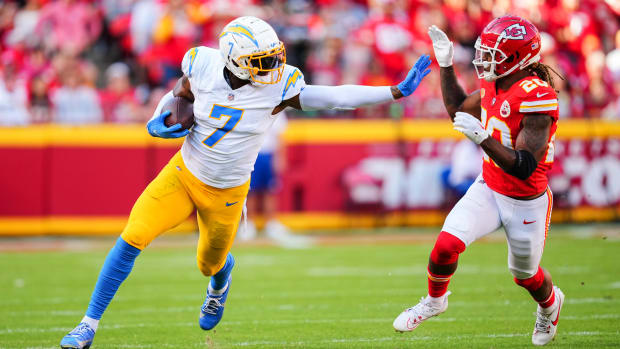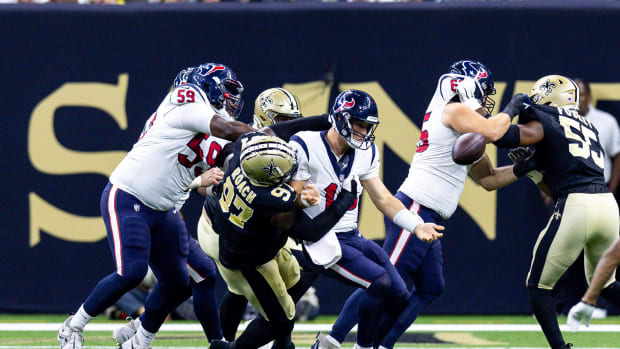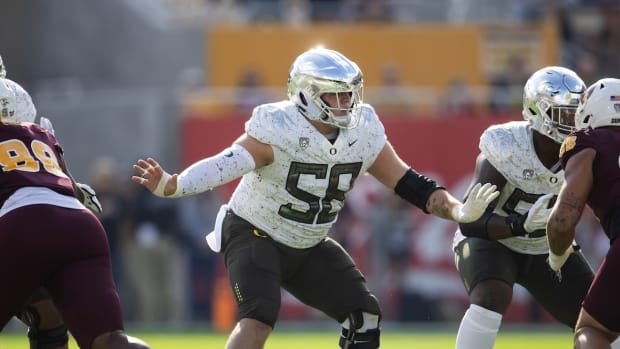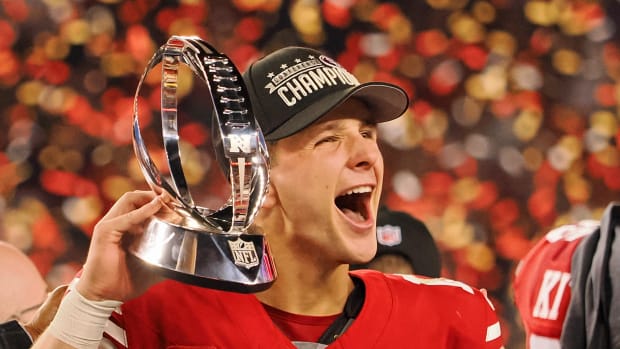
The Salary Cap Myth, and More Insights Into Deal-Making Season
We are entering a key stretch for the business of football. It is the time when teams architect, assemble and mold the product they desire for the 2015 season. Taking the handoff from the coaches and players, this is the time for the front office—general managers, scouts, salary cap managers, contract negotiators, etc.—to shine.
From a front-office perspective, it was always amusing how so many matters involving money—contracts, cap, restructures, guarantees, etc.—were portrayed in the media and perceived by fans. Much of the information, of course, is spun by agents, known this time of year as “league sources.” With that, here are a couple insights from experience about financial information you are going to see in the coming days and weeks to help cut through the spin, as well as my thoughts on the continuing fortune of Larry Fitzgerald and L.A.’s siren song.
The Cap Myth
Having managed the NFL salary cap for 10 years, I learned the secret to managing it was getting to a point where cash and cap room used lined up as evenly as possible. Once a “pay as you go” philosophy takes hold, a team can avoid piling up future charges and can always have flexibility.
Here’s a lesson I tell every agent and player about NFL contracts: Ignore the cap; it is simply an accounting mechanism for the team. Through the loophole of prorated signing bonuses, the NFL’s “soft cap” (think yarmulke) can easily be manipulated and often portrays an inaccurate picture of the team’s player finances. Rather, focus on the cash.
As an example, say a free agent player desires $20 million—between bonus and salary—in the first year of a five-year deal. Both a cap-strapped team and a cap-healthy team could make it work if they wanted to, albeit with very different structures. The cap-strapped team would put most of that $20 million into a signing bonus, prorating roughly $15 million for cap purposes over future years. The cap-healthy team would pursue the “pay as you go” model, loading most or all of that $20 million into 2015 (with no need for a prorated bonus) and avoid future leftover charges on the player.
A Hero's Welcome
An undrafted free agent who once worked at Popeyes for $7.25 an hour became the unlikely star of Super Bowl XLIX. The MMQB followed Malcolm Butler home to Vicksburg, Miss., where everyone already knew his name.
FULL STORY
Thus, while ample cap room protects against future charges, the lack of cap room rarely prevents present moves. Teams often use “lack of cap room” as an excuse to not retain or to release players. The truth, of course, is that if they really want to keep or add players, they will, damn the future consequences.
As an example, the Saints were one of the most cap-strapped team in the NFL last season, if not the most (and are again this season), yet they signed the highest-paid 2014 free agent (in terms of guaranteed money) in Jairus Byrd. The soft and malleable cap allowed for that.
Restructure vs. Reduction
With the fungible cap, teams approach their highest-salaried players to “bonus out” their salary; i.e., convert it to prorated signing bonus to create cap room. For players, there is no downside to these paper transactions. The cash is the same, often with even better payment terms, and the increases in future cap numbers may give them more leverage against being released.
Sometimes, however, these “restructures” are truly “reductions.” Teams are not only asking the player to move money around; they are asking the player to take less money. Requests for reductions can be risky, as some teams merely do so to save face with popular players nearing the end of their careers. The problem, however, is that the player may say yes, and the team truly does not want the player back at any price. This is why you see players released who wonder why the team never offered them an opportunity to take less.
The other risk with reduction requests involves credibility. If a player rejects a pay cut and the team responds with less of a reduction—or no reduction—it loses credibility for future deals not only with that player, but with all players. Every player and agent will know that when that team asks for a pay cut, they don’t really mean it.
When receiving an offer for a potential pay cut, an agent must use team relationships to determine if the player is better off taking the reduced rate or what he finds is behind Door No. 2.
Thus, not all restructures are created equal. Speaking of which….
Fitz’s Fortune
Larry Fitzgerald agreed on a restructure and a fully guaranteed reduction with the Cardinals to ensure his status as the rare modern athlete to play with the same franchise over a long and successful career.
Fitzgerald’s continued presence on the Cardinals was not a certainty. Many had forecast a divorce, with him landing with a team such as the Patriots or Seahawks. Lacking in those forecasts, however, was an understanding of the deep relationship between Fitzgerald and Cardinals owner Michael Bidwill. The latter has long admired Fitzgerald’s professionalism and ability to rise above any negativity associated with the team. Fitzgerald traded on that relationship last week in ensuring continued guaranteed earnings through what he sees as the end of his career in two years at age 33.
Fitzgerald’s contract savvy means he’ll have earned some $140 million by the time he hangs ’em up. (Chris Keane for Sports Illustrated/The MMQB)
Fitzgerald will now make $11 million fully guaranteed both this year and next. He was scheduled to make $31 million over that time period—$16 million this year and $15 million next—yet those amounts were not guaranteed, and Fitzgerald was vulnerable to being released, if not this year then certainly next. Thus, Fitzgerald traded $31 million in nonguaranteed money for $22 million in guaranteed money. I would have made that trade, at that age and at that position, every day of the week.
Although the Cardinals retain their signature player and create immediate cap room, they have—as discussed above—kicked the cap can down the road once again. The millions of saved cap room will now be deposited into Fitzgerald’s future account, eventually leaving behind a massive cap debt when the inevitable parting with Fitzgerald comes after the 2016 season.
With NFL finances clearly tilted towards management, there are few outliers who have “won” on the business side like Fitzgerald. He has negotiated not one, not two, but three standard-setting wide receiver contracts. With present career earnings of $118 million, Fitzgerald has now ensured total career earnings of $140 million. For comparison purposes, Andre Johnson, the third pick in the 2003 draft, has career earnings of $89 million, almost $30 million below Fitzgerald, the third pick in the 2004 draft. Just as Fitzgerald’s next two years with the Cardinals are secure, so is his—in NFL player terms—vast fortune.
L.A. Calling
Atlanta's New Attitude
New Falcons coach Dan Quinn tells Jenny Vrentas what it was like going from losing the Super Bowl to his dream job in a 24-hour span, explains his coaching style and details what kind of player Atlanta will target with the No. 8 pick in the draft. FULL STORY
In the first NFL owners meeting I attended, in the spring of 1999, one of the top agenda items concerned a team in Los Angeles. That was 16 years ago, with L.A. never gaining traction. Now, with
three
current owners jockeying for position with two different stadium plans, there may be that traction.
When Rams’ owner Stan Kroenke acquired land in Inglewood, Calif., last year, he put a stake in the ground—literally and figuratively—as the frontrunner in the chase for L.A. And the inevitable response has come: City leaders in St. Louis and the governor of Missouri have stepped up their efforts to show Kroenke the money.
Now come the Chargers and Raiders who, exasperated with their out-of-date stadium circumstances, have joined forces with a stadium plan in Carson, Calif., (a site rejected by the NFL years ago). They are saying all the right things about exhausting options with their home jurisdictions and respecting the NFL relocation process, but the message is clear: like St. Louis, San Diego and Oakland need to step up. And if they don’t? Well, the brinksmanship will ratchet up towards the potential of drastic change in the NFL landscape in 2016. Options create leverage, and the lure of L.A. gives teams leverage of another enticing option.
NFL owners have never been above forging the best deal possible for themselves. Wealthy NFL owners do not “need” their local municipalities to help finance state-of-the-art stadiums (nor did they “need” a better deal with the players in the most recent CBA). However, they negotiate favorable terms because, well, they can. Stadium economics has become one of the most important pieces of the NFL ownership profit puzzle, and L.A. is the biggest chess piece yet. Stay tuned.
Follow The MMQB on Facebook, Twitter and Instagram.
[widget widget_name="SI Newsletter Widget”]








































